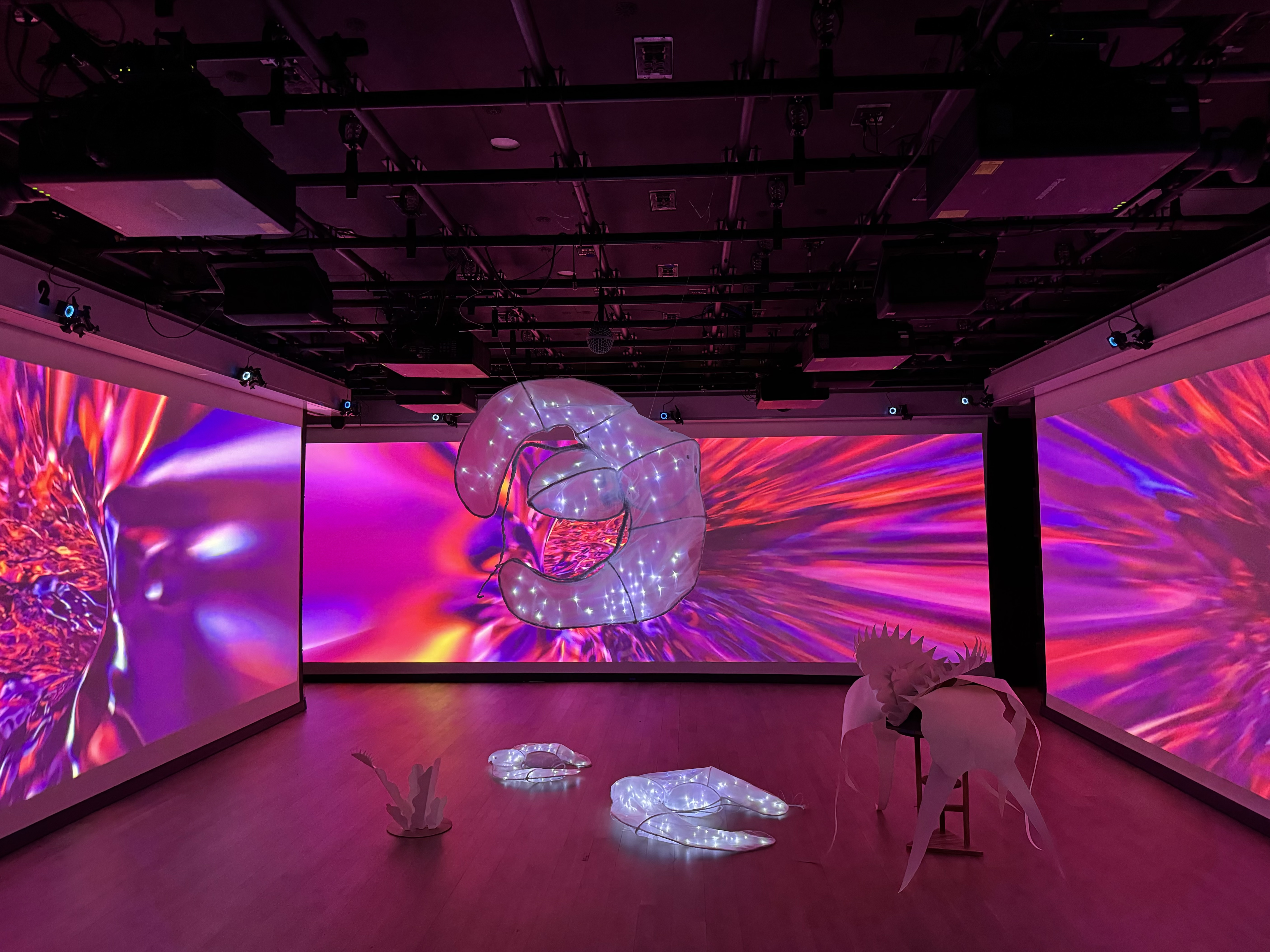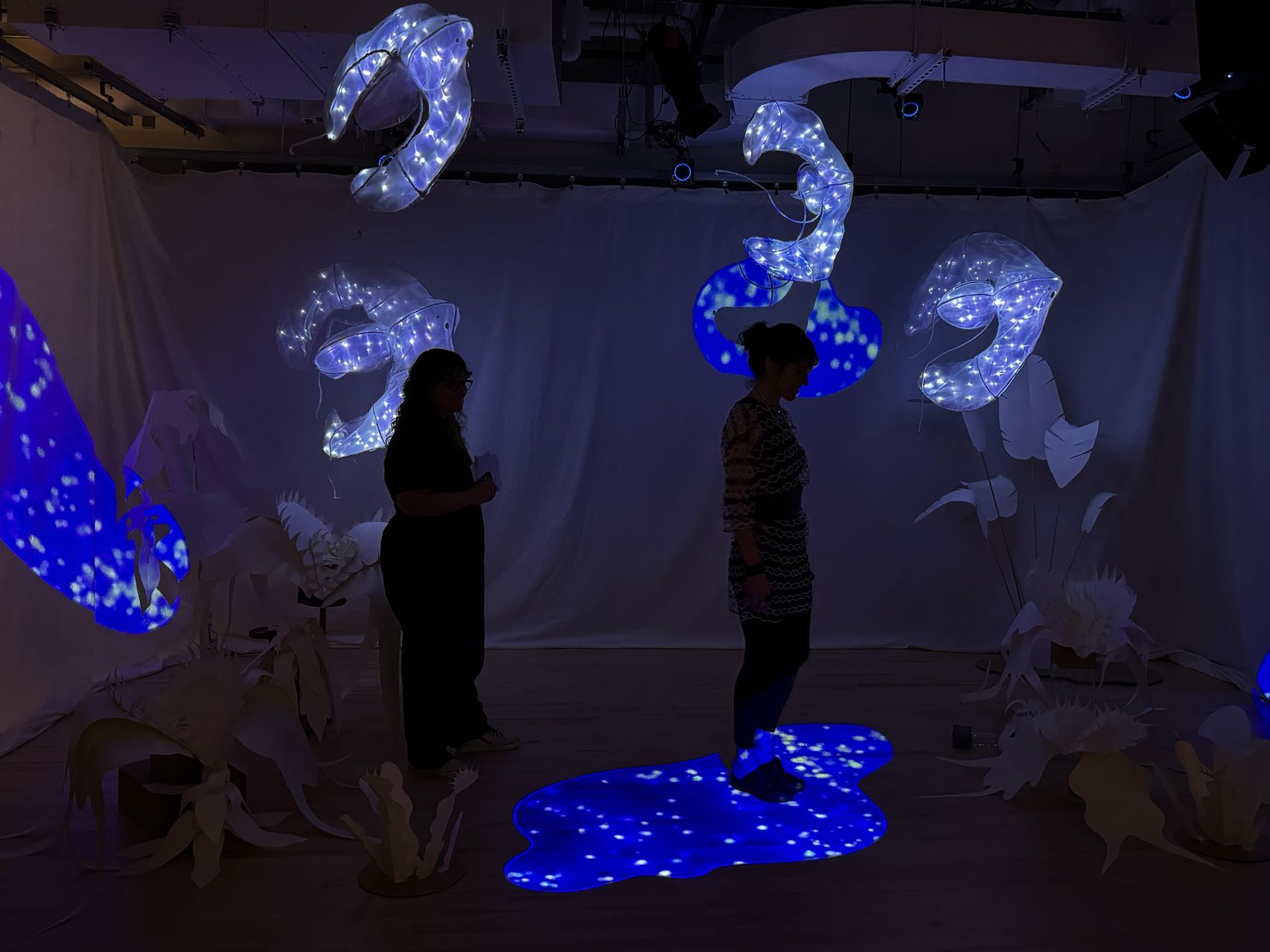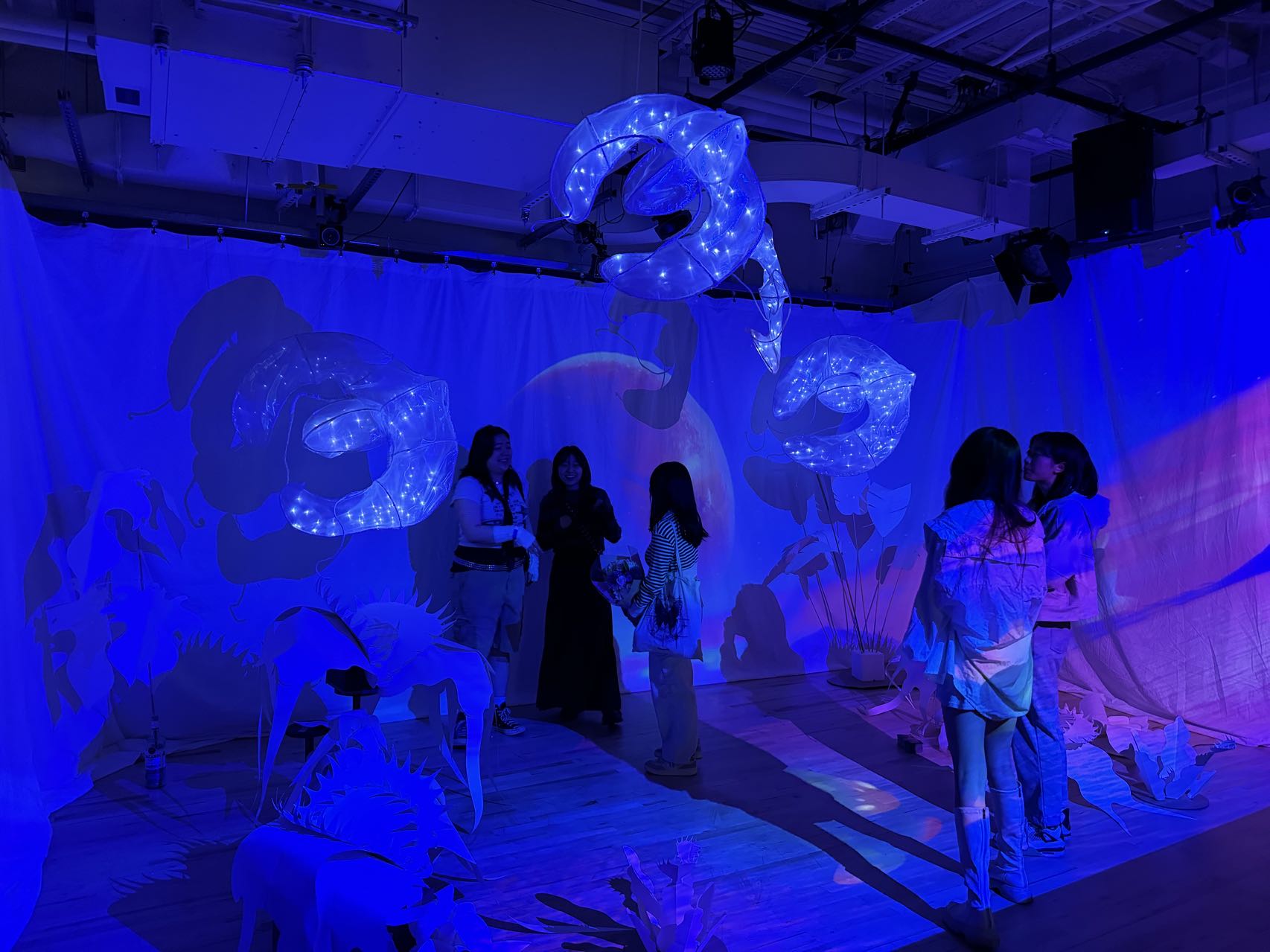“aetheria-124c”
Aetheria is a two-part interactive immersive experience.
"Aetheria" is an immersive experience that invites participants to explore the intricate ecological dynamics between species on Earth and a hypothetical habitable planet light years away. Through a combination of interactive displays, projections, and physical installation, this exhibition challenges the boundaries between science education, art, and imagination.
︎ Team Members: Phoebe Yin, Nertinia Tang
”![]()
![]()

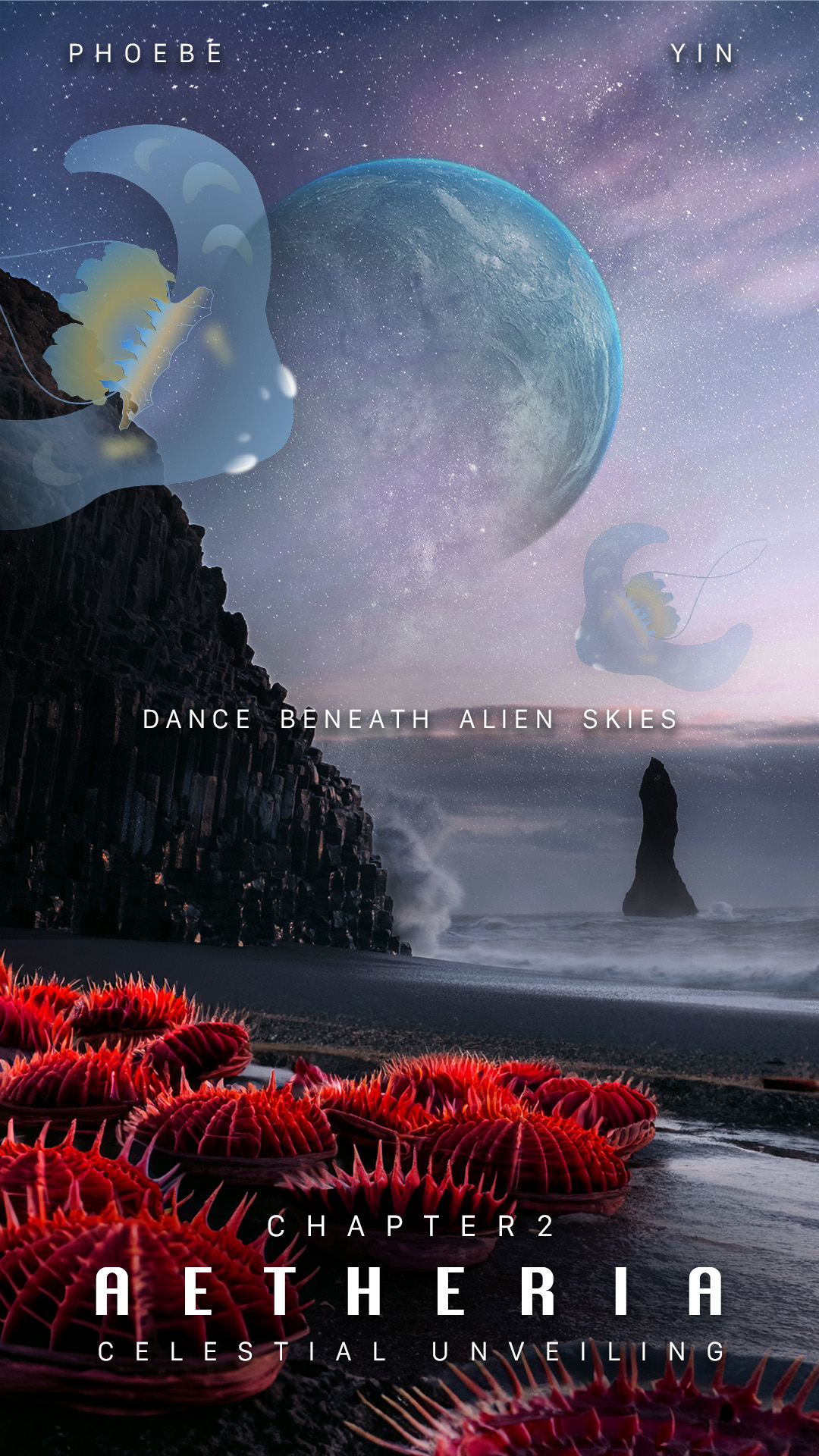
Chapter 1: Illuminating Harmony provides an insightful look into the symbiotic relationship between Golden Jellyfish and photosynthetic algae in Palau, examining how similar species might thrive on a habitable exo planet adapting to vastly different environmental conditions. Through interactive displays and educational videos, audiences are encouraged to actively learn and to reflect on how these relationships in nature could serve as tools for sustaining life both on Earth and beyond.
Chapter 2: Celestial Unveiling brings the alien world to life through immersive projections and installations that blend physical and digital interactive components, showcasing the changing landscapes and thriving species of Aetheria-124c. By stepping into this speculative ecosystem, visitors engage with and co-create among life-sized alien flora and fauna, prompting them to appreciate and reconsider their relationships with the natural world and contemplate the interconnectedness of all living things.
“video”
The two chapters offer participants an unique yet cohesive experience to learn and explore about our home and the distant alien world.
“concept”

Palau’s Jellyfish Lake is a marine lake isolated from the open ocean. Over thousands of years, the jellyfish have evolved in isolation, making them genetically distinct from their oceanic relatives.
The ~5 million golden jellyfish that live in the lake have a unique relationship with symbiotic algae, zooxanthellae, that reside within their tissues.
The algae produce energy via photosynthesis, which the jellyfish use as a primary energy source. To maximize sunlight exposure, the jellyfish migrate across the lake daily in a cycle known as "sun migration. To avoid their predators, jellyfish stay away from the shadowed edges where sea anemones reside.
Envisioning a potentially habitable planet within a star system 628 light years away from Earth, how might the golden jellyfish, its symbiotic partners, and its predators undergo evolutionary transformations?
The algae produce energy via photosynthesis, which the jellyfish use as a primary energy source. To maximize sunlight exposure, the jellyfish migrate across the lake daily in a cycle known as "sun migration. To avoid their predators, jellyfish stay away from the shadowed edges where sea anemones reside.
Envisioning a potentially habitable planet within a star system 628 light years away from Earth, how might the golden jellyfish, its symbiotic partners, and its predators undergo evolutionary transformations?
Based on research on planetary habitability and terrestrial analogues, star system Aetheria-124 was designed, with a focus on one planet that’s within the habitable zone, Aetheria-124c. Inspiration was drawn from NASA’s studies, particularly Kepler-186f and Venus, during the creative process of designing Aetheria-124c. Kepler-186f, an Earth-sized exoplanet in the habitable zone of the red dwarf star system Kepler-186, shares many defining characteristics with Aetheria-124c.
Aetheria-124c, the second planet orbiting the host star, has a mass approximately twice that of Earth. Distinguished by its significantly denser atmosphere, this planet features a thick air layer that acts as a supportive cushion for heavier objects. Aetheria-124 is classified as a class K/M orange/red dwarf star. Unlike our Sun, this type of star is smaller in mass, cooler in temperature, and has lower luminosity. On Aetheria-124c, mid-day might resemble sunset on Earth.
Red dwarf stars are known for their relative instability and periodic bursts of radiation. Because of its proximity to the host star, Aetheria-124c receives a significant amount of stellar flares. Consequently, life on this planet has had to adapt to these extreme conditions.
Aetheria-124c, the second planet orbiting the host star, has a mass approximately twice that of Earth. Distinguished by its significantly denser atmosphere, this planet features a thick air layer that acts as a supportive cushion for heavier objects. Aetheria-124 is classified as a class K/M orange/red dwarf star. Unlike our Sun, this type of star is smaller in mass, cooler in temperature, and has lower luminosity. On Aetheria-124c, mid-day might resemble sunset on Earth.
Red dwarf stars are known for their relative instability and periodic bursts of radiation. Because of its proximity to the host star, Aetheria-124c receives a significant amount of stellar flares. Consequently, life on this planet has had to adapt to these extreme conditions.


“alien ecosystem”
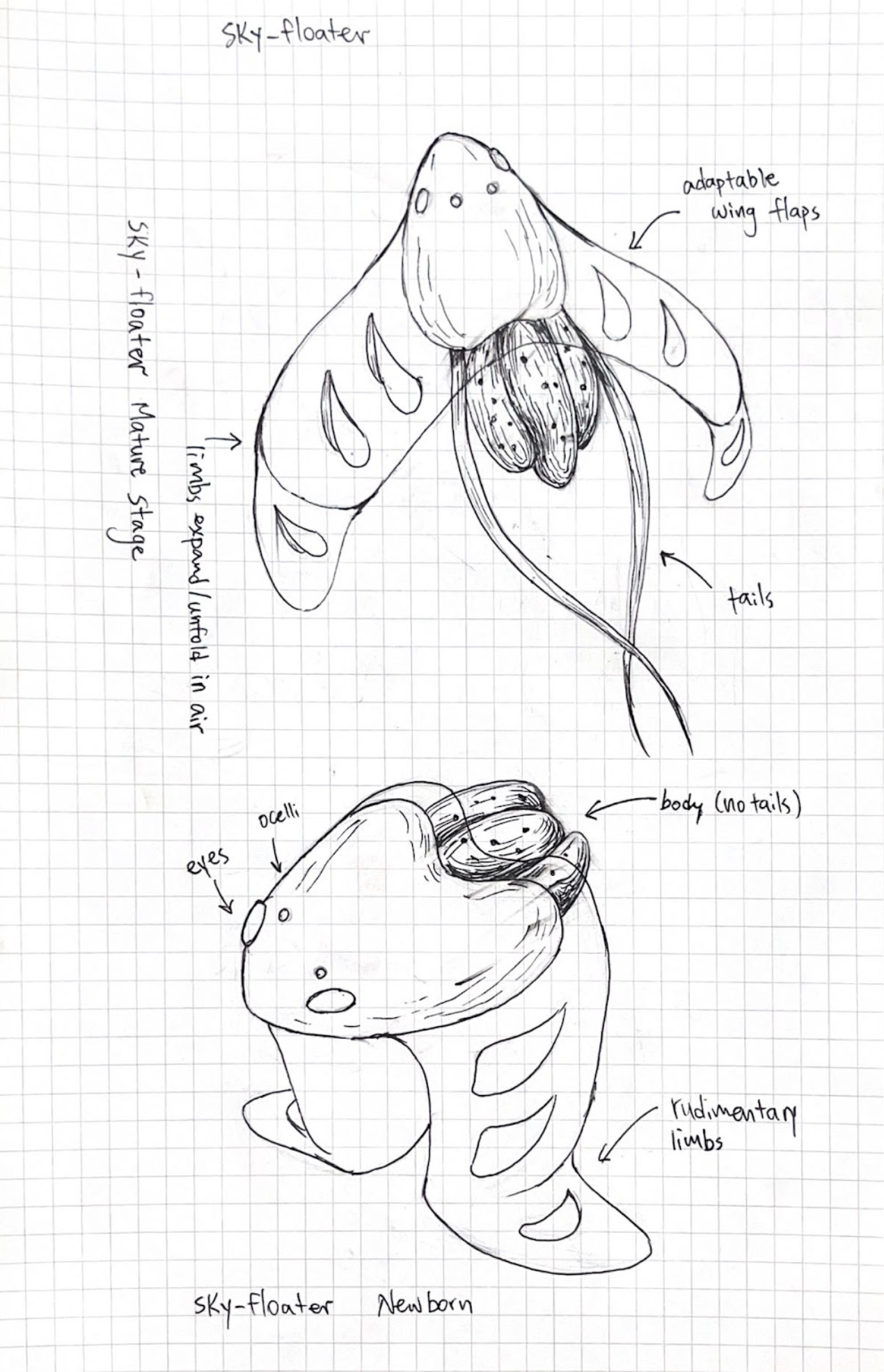
 sky-floater and anemorph concept sketch
sky-floater and anemorph concept sketch
The environment of Aetheria-124c facilitates species to effortlessly glide through the air for extended periods. Could the evolutionary processes on Aetheria-124c have enabled the “jellyfish” to transcend the confines of water-exclusive survival?
Sky-floaters are an aerial species unique to Aetheria-124c. They are symbiotically linked with azural algae, and track the sun to optimize photosynthesis. In return, the algae provide nutrients and shield them from harmful stellar radiation, emitting a soft blue glow.
The “wings” of this species serve a dual purpose for both gliding and walking. The sky-floater newborns are born with rudimentary limbs that fold outwards to allow terrestrial movement. When they start to mature, they would stroll to the edge of cliffs, extending their limbs before taking a leap, transitioning into a long, graceful glide before they become adults and reproduce.
Anemorphs, a slow-moving carnivorous species flourishing in the terrains of the planet, wait for the sky-floaters to descend closer to the ground and faint them with toxic gas. As the affected sky-floaters fall to the ground, the anemorphs close their traps, starting the gradual digestion of their prey.
Sky-floaters are an aerial species unique to Aetheria-124c. They are symbiotically linked with azural algae, and track the sun to optimize photosynthesis. In return, the algae provide nutrients and shield them from harmful stellar radiation, emitting a soft blue glow.
The “wings” of this species serve a dual purpose for both gliding and walking. The sky-floater newborns are born with rudimentary limbs that fold outwards to allow terrestrial movement. When they start to mature, they would stroll to the edge of cliffs, extending their limbs before taking a leap, transitioning into a long, graceful glide before they become adults and reproduce.
Anemorphs, a slow-moving carnivorous species flourishing in the terrains of the planet, wait for the sky-floaters to descend closer to the ground and faint them with toxic gas. As the affected sky-floaters fall to the ground, the anemorphs close their traps, starting the gradual digestion of their prey.
“ final designs ”

Golden Jellyfish and Zooxanthellae
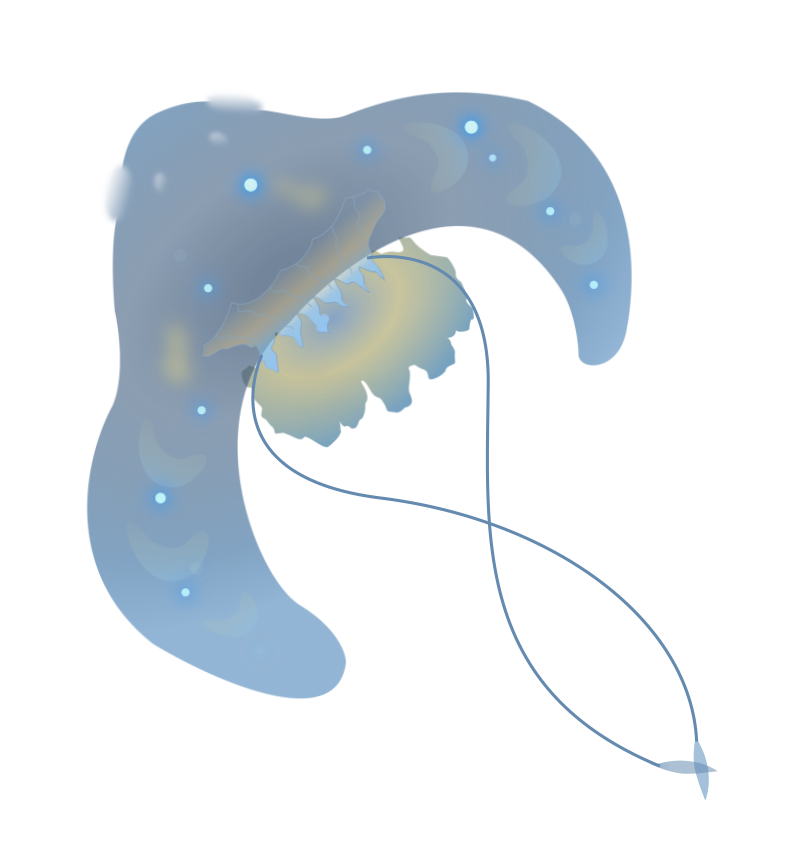
Sky-Floater and Azural Algae

Sky-Floater Newborn

Anemorph
“chapter 1”

Chapter 1: Illuminating Harmony occupies the front half of the space. Two 75-inch monitors are set up to face the left and right corners of the room, each
projecting its interaction simultaneously. The hand motions of the participants are captured when standing in front of the screens.


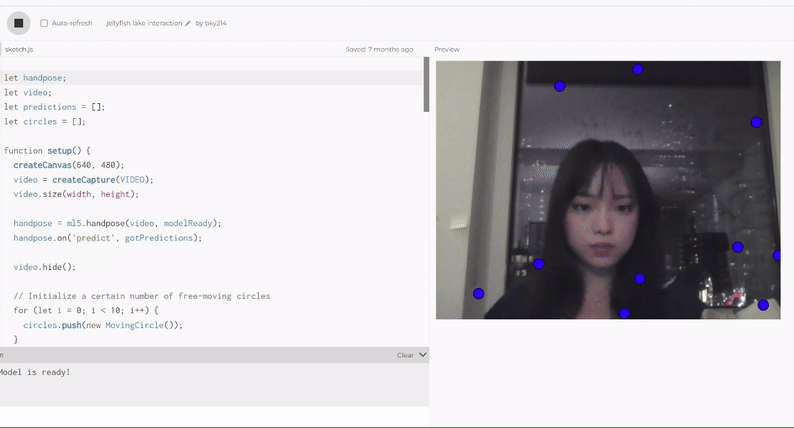
Jellyfish Lake Interaction Prototype
The interaction projections are created using p5.js. To simulate the mesmerizing effect of a jellyfish swarm following the sun, the ml5.js library—built on top of TensorFlow.js—was utilized, leveraging its pre-trained models for tasks like hand tracking. This interaction allows users to control the sun, observing the golden jellyfish’s tendency to always follow the sun.
The interaction projections are created using p5.js. To simulate the mesmerizing effect of a jellyfish swarm following the sun, the ml5.js library—built on top of TensorFlow.js—was utilized, leveraging its pre-trained models for tasks like hand tracking. This interaction allows users to control the sun, observing the golden jellyfish’s tendency to always follow the sun.
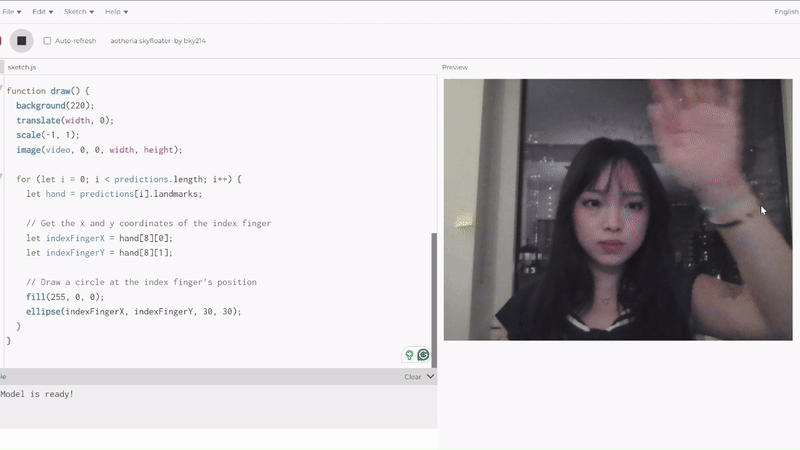
Sky-floater Interaction Prototype
Instead of controlling the sun to attract jellyfish, this interaction allows users to control the skyfloater to chase the sun, understanding the similarities and differences between the alien species and the golden jellyfish.
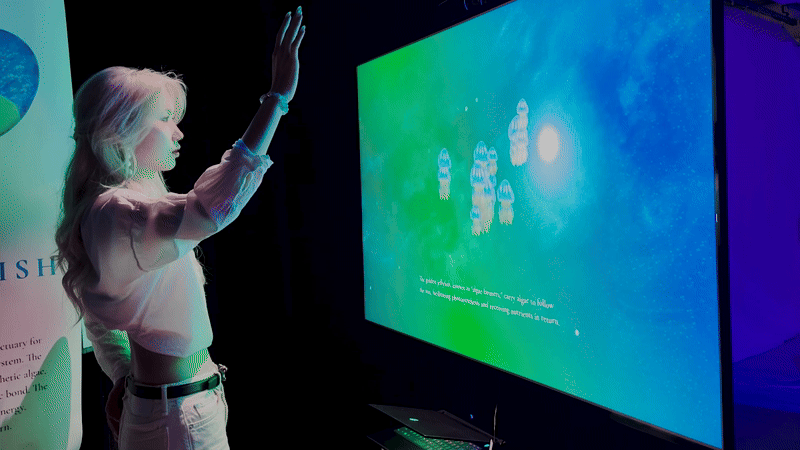
Jellyfish Lake Interaction︎
On-screen prompts invite users to explore the symbiotic relationship between the golden jellyfish, algae, and the sun. For those seeking more in-depth information, a detailed poster provides further insights.

As the sky-floater approaches the moving sun, the azural algae within its body illuminate, indicating the dynamic interaction between this alien species and its environment.

“chapter 2”

Chapter 2 is an immersive installation that occupies the back of the space aiming to create a portal to a small fragment of Aetheria-124c. Above the
audience, the sky-floaters hover, oriented towards the projected sun on the wall, while
they are surrounded by alien flora made from white paper on the ground. The projected animation represents the day-to-night cycle on Aetheria-124c. Below, the Anemorphs
flourish, inviting the audience to step into this strange forest. Accidentally getting too close to the anemorph would trigger a change in the environment: a sudden burst of red,
explosive animation accompanied by unsettling sounds, signaling the impending arrival
of a stellar flare.



Sky-floater Models
The sky-floater model is crafted using a 1.6mm wire frame, white pipe cleaners, plastic sheeting, iridescent fabric, and remote-controlled fairy lights to replicate the jelly-like, bioluminescent qualities of the creature.



Anemorph Models
The design of the anemorph draws inspiration from the golden jellyfish’s natural predators - sea anemones. On Aetheria-124c, t he anemorph is a terrestrial species that hide their identities with leaf and flower-like structures, tricking others into assuming they are plants. The anemorph is mostly stationary. However, its pedal disk allows it to move across the terrain at a very slow speed. The models are made with white paper to allow vivid projection effects.
![]()
![]()
![]()
The design of the anemorph draws inspiration from the golden jellyfish’s natural predators - sea anemones. On Aetheria-124c, t he anemorph is a terrestrial species that hide their identities with leaf and flower-like structures, tricking others into assuming they are plants. The anemorph is mostly stationary. However, its pedal disk allows it to move across the terrain at a very slow speed. The models are made with white paper to allow vivid projection effects.

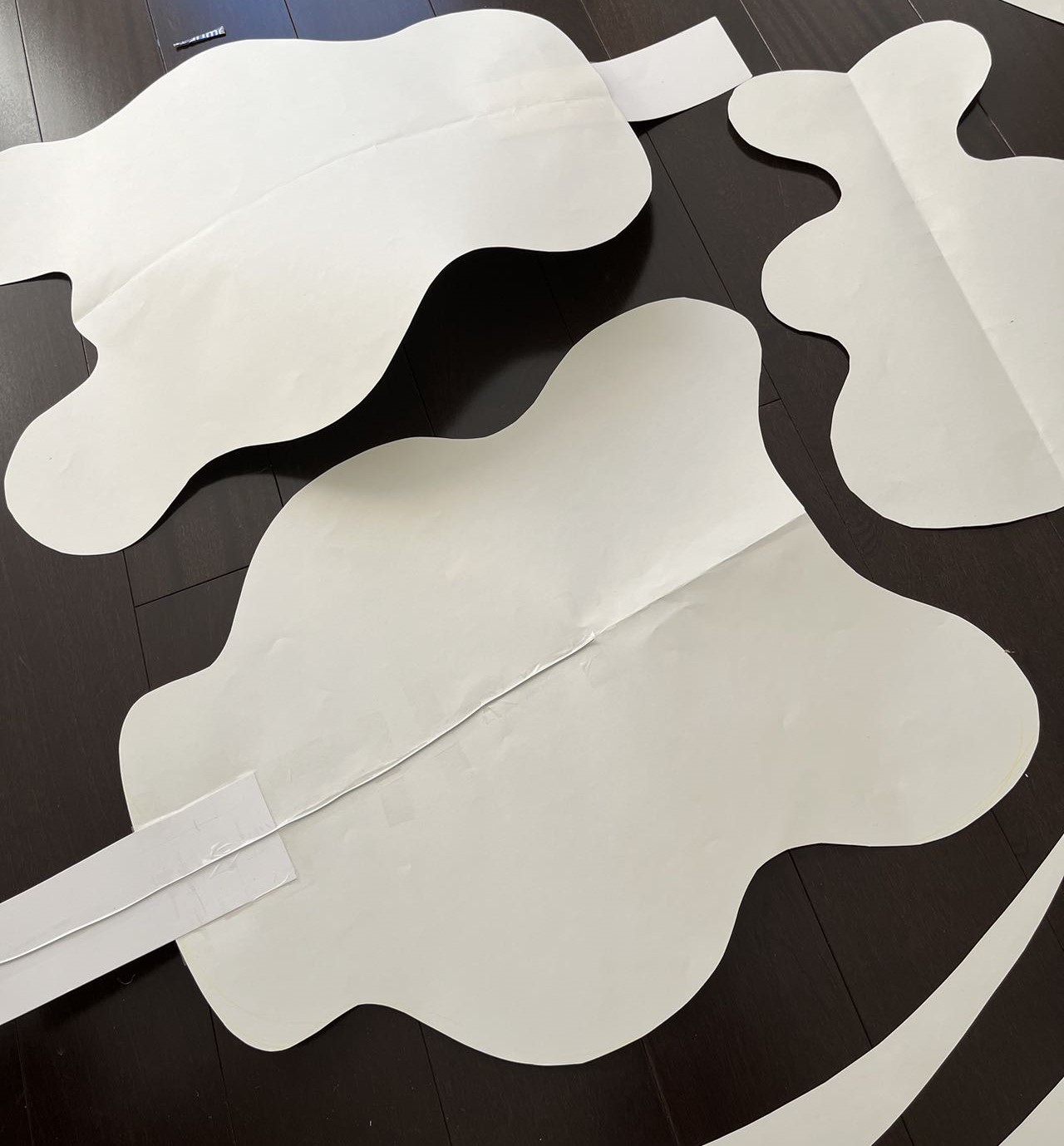


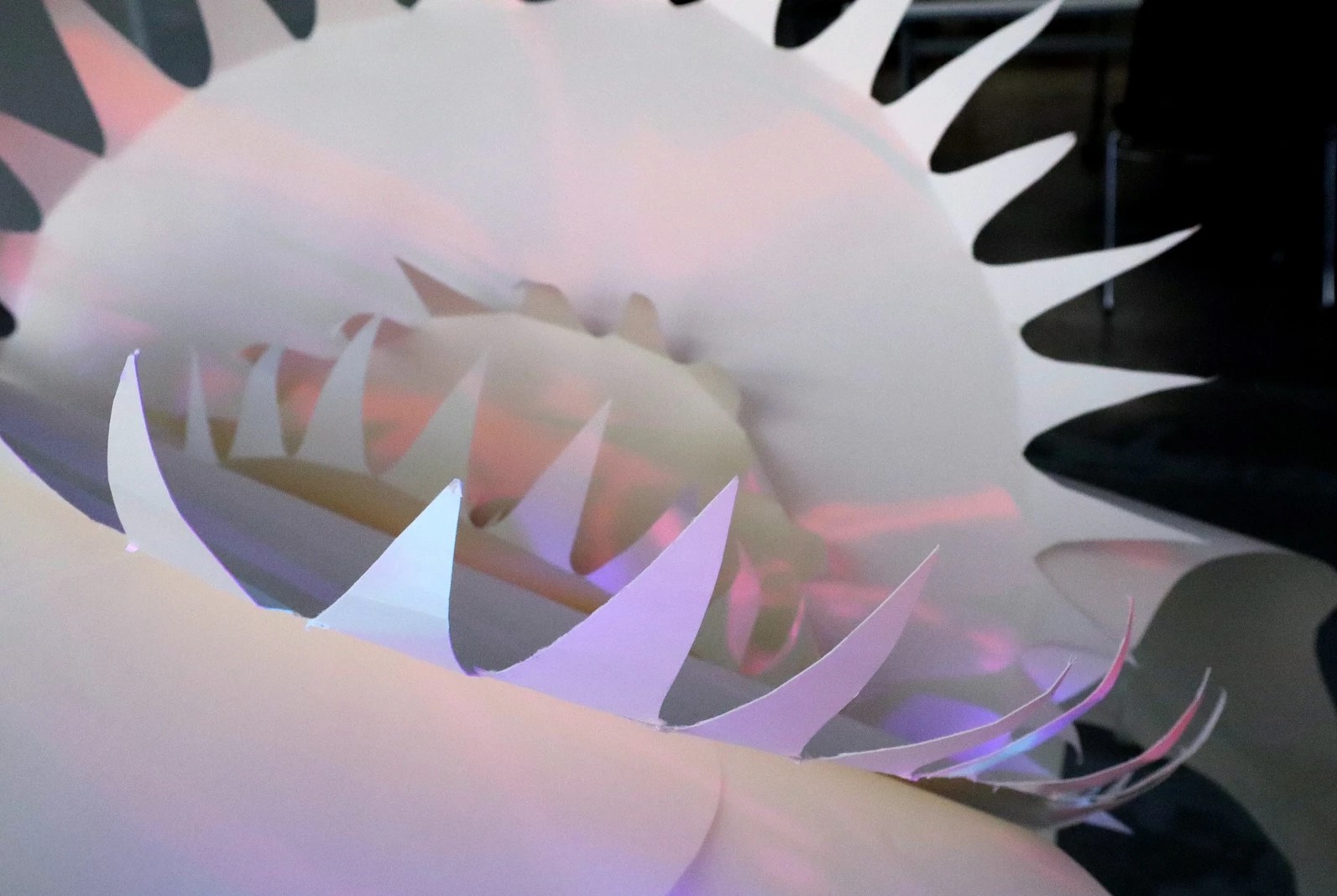


Animation, Visual, Projection Mapping
The six-scene day-to-night cycle illustrates various scenarios on Aetheria-124c. These scenes include animated footage depicting the forest, clouds, ocean, aerial terrain, and bioluminescence, offering a “tour” of the alien planet’s diverse landscapes.
While working on this project, the importance of considering physical space when creating an immersive experience became evident. During projection testing, animations and scenes were specifically tailored to a 3D setting that encompassed the three surrounding walls and the floor. The visuals were designed to integrate with the spatial dimensions, enhancing the overall immersive experience.
Visual Mockups
![]()
![]()
![]()
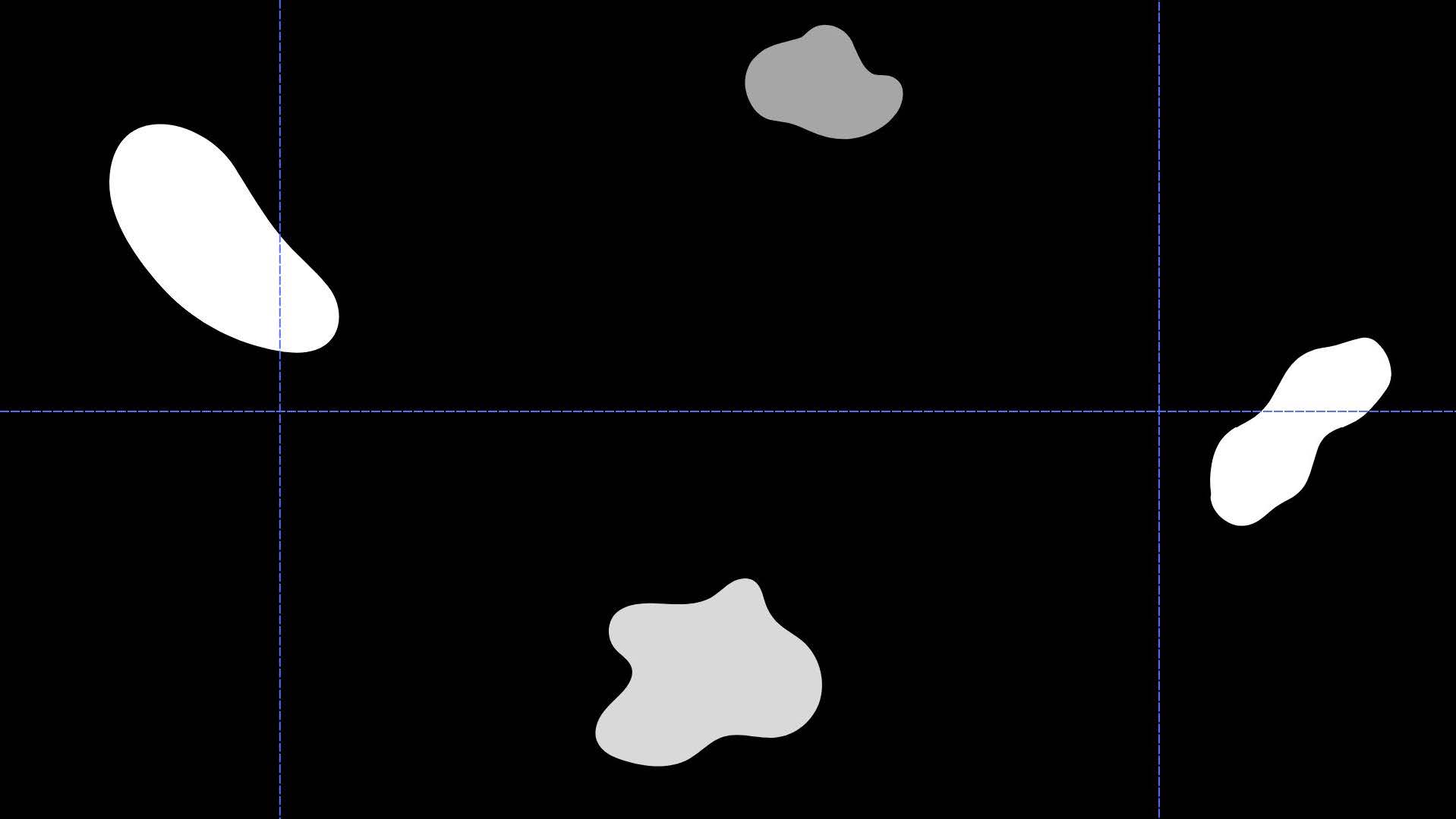




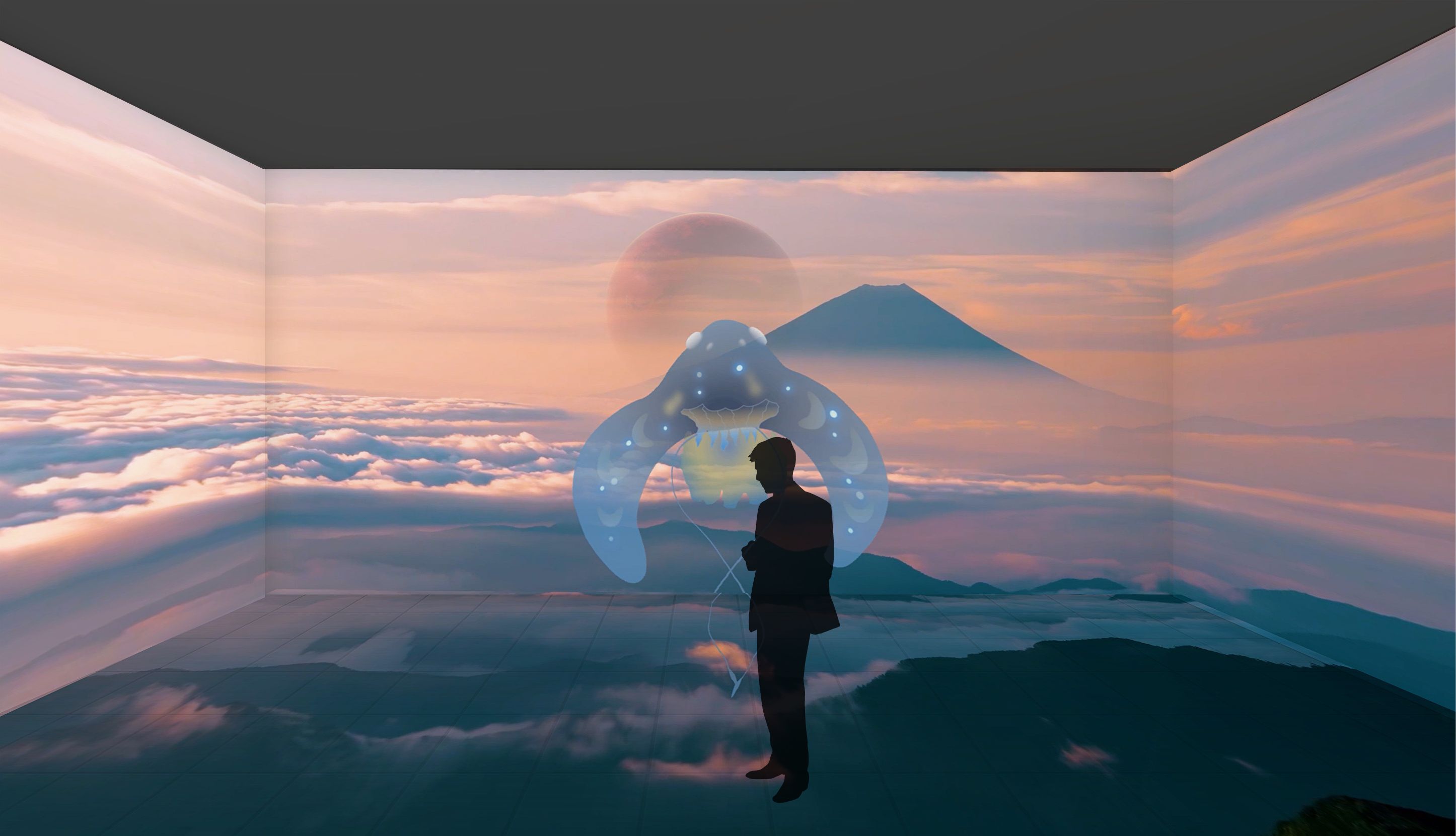
AV control, Stellar Flare Interaction Control
The audio, visual, and interaction are handled by MAX/MSP and arduino.
To achieve the step on stellar flare interaction, a Force Sensitive Resistor (FSR) is connected to a computer, outputting either 1 or 0 based on input. The code displays these values in the serial monitor, where 1 indicates pressure and 0 indicates no pressure. To ensure accurate detection, the threshold is set to 800 after testing revealed the sensor's high sensitivity, with light touches exceeding 900 on a scale of 0 to 1023.
On the receiving end, MAX/MSP processes the Arduino's outputs, controlling projection animations and sound. When MAX receives a 0, it starts the day-to-night cycle on Aetheria; when a participant steps on the FSR, a 1 triggers the stellar flare animation. A gradual transition effect smoothly adjusts audio and visuals as the scene shifts between the stellar flare and the normal cycle, ensuring seamless continuity.
To prevent repeated triggering during the stellar flare animation, a timer halts input detection for 30 seconds after activation. The serial monitor remains inactive during this period.
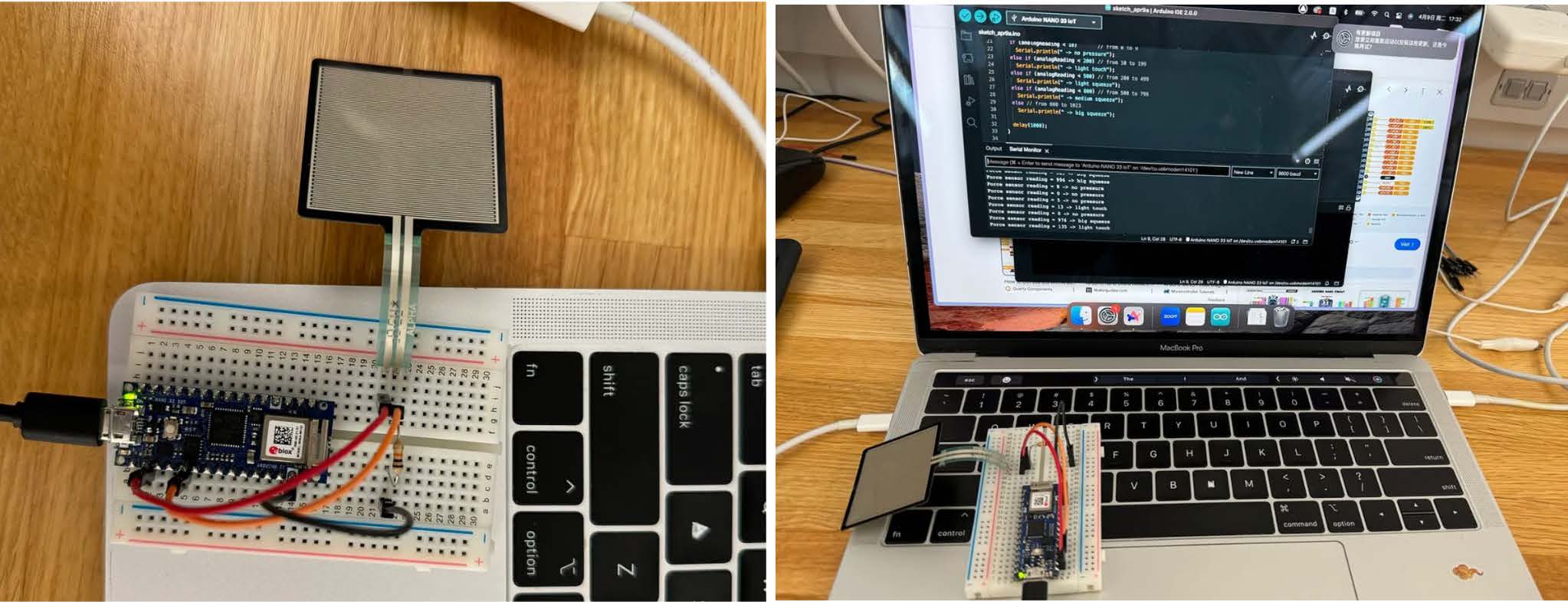
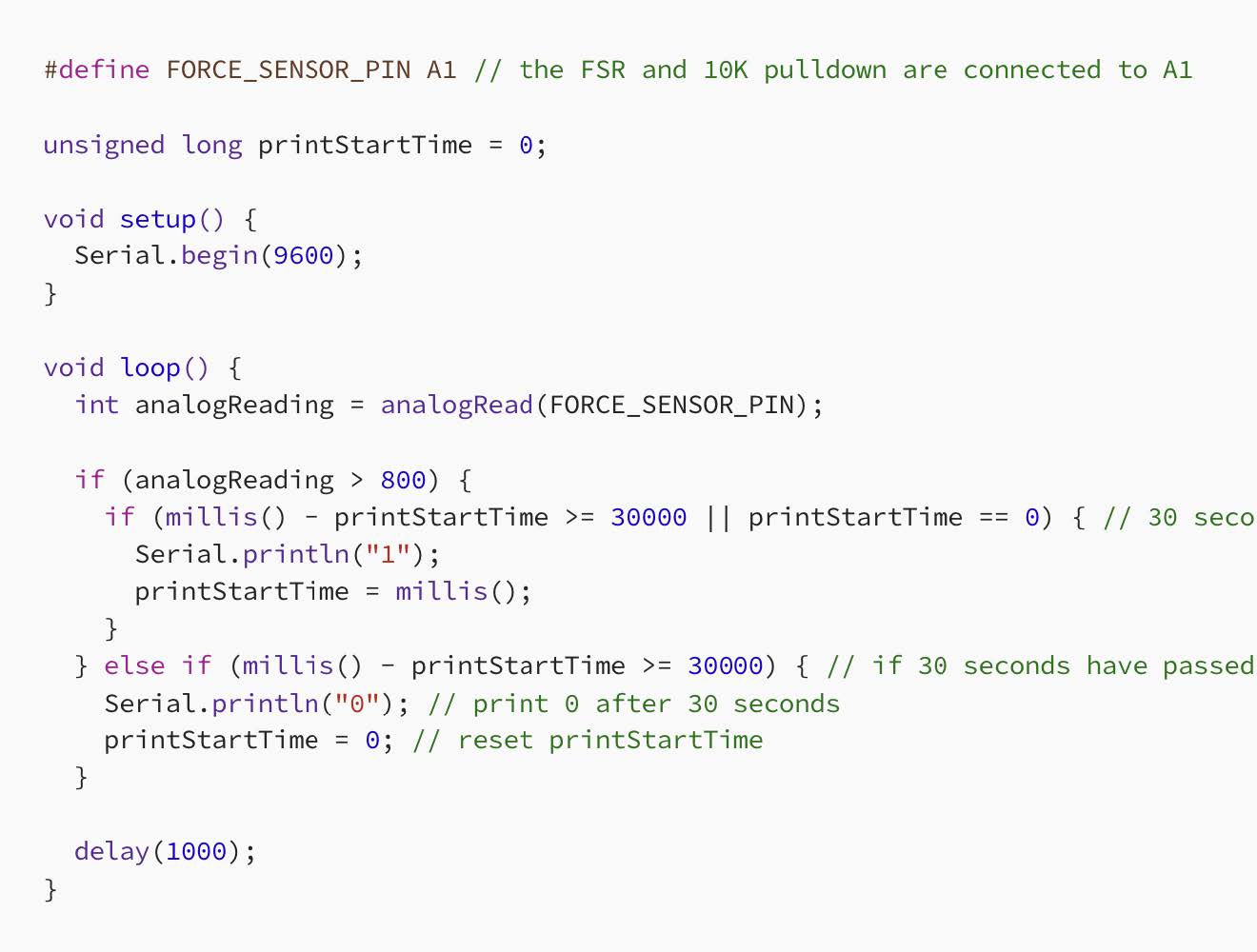
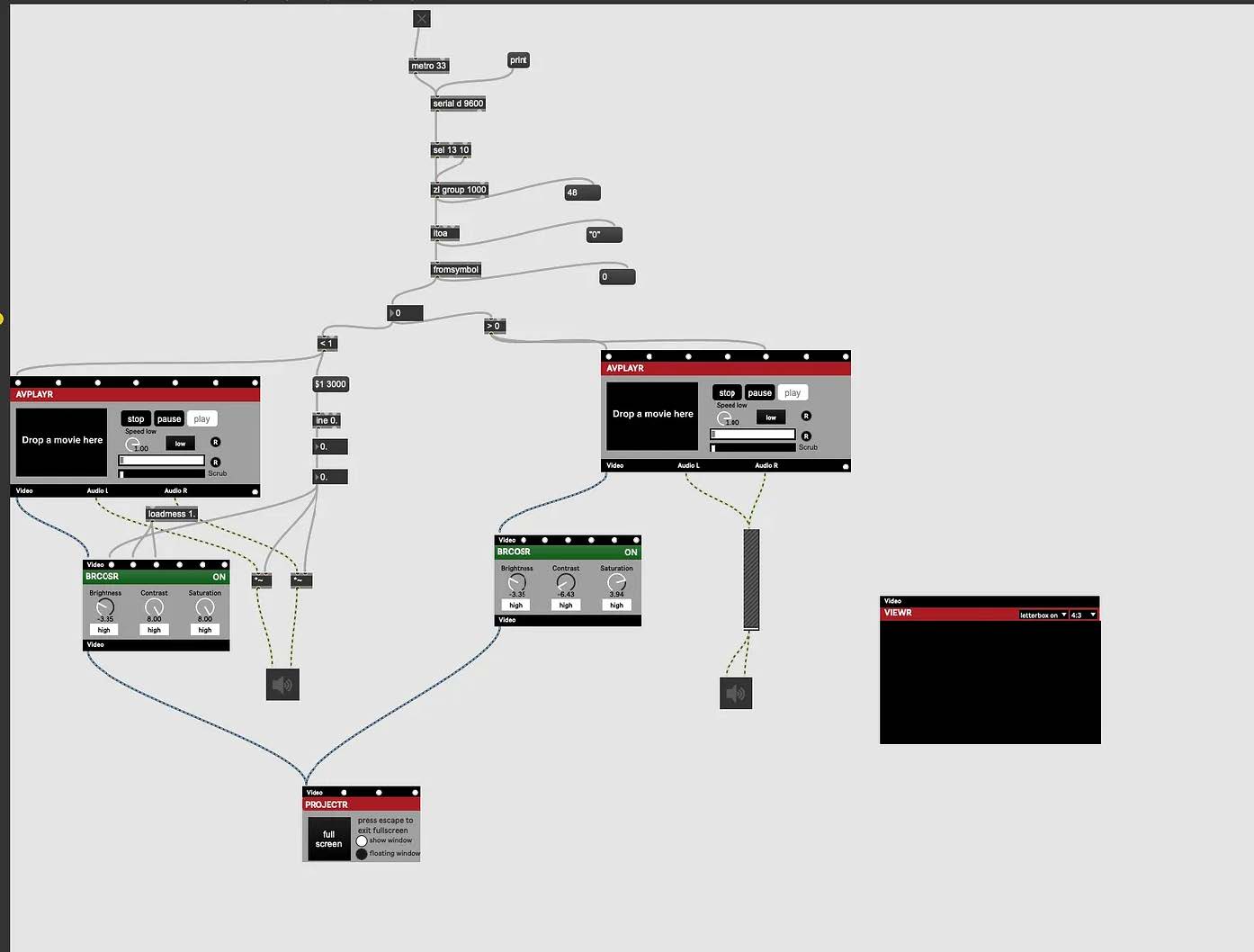
“images”




